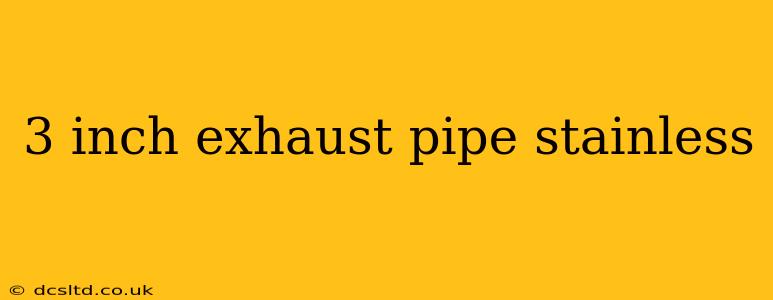Choosing the right exhaust system for your vehicle is crucial for performance, sound, and longevity. A 3-inch stainless steel exhaust pipe is a popular choice for many car and truck enthusiasts, offering a balance of performance gains and durability. This guide will explore everything you need to know about 3-inch stainless steel exhaust pipes, addressing common questions and concerns.
What are the benefits of a 3-inch stainless steel exhaust pipe?
A 3-inch stainless steel exhaust pipe offers several key advantages:
-
Increased Horsepower and Torque: The larger diameter allows for less restriction of exhaust gases, leading to improved engine breathing and potentially noticeable gains in horsepower and torque, particularly at higher RPMs. The exact increase depends on the entire exhaust system and engine modifications.
-
Improved Sound: A larger diameter pipe can significantly alter the exhaust note. While not always louder, it can often produce a deeper, more resonant sound. This depends heavily on muffler selection and other components of the exhaust system.
-
Durability and Longevity: Stainless steel is highly resistant to corrosion and rust, ensuring a longer lifespan compared to other materials like aluminized steel. This translates to less maintenance and a longer-lasting investment.
-
Increased Flow: The larger diameter allows for a smoother and more efficient flow of exhaust gases, reducing backpressure and maximizing engine performance.
-
Aesthetic Appeal: Many enthusiasts appreciate the sleek and polished look of stainless steel exhaust components. This can enhance the overall appearance of the vehicle's undercarriage.
What size engine is a 3-inch exhaust pipe suitable for?
This is a crucial question, and there's no single definitive answer. The suitability of a 3-inch exhaust pipe depends heavily on engine displacement, naturally aspirated versus forced induction, and other modifications. Generally speaking, engines with larger displacements (e.g., V8s, larger V6s) benefit more from a 3-inch exhaust system than smaller engines (e.g., 4-cylinder). However, even smaller engines can benefit if other modifications like turbocharging or supercharging are present. It's best to consult with exhaust specialists or forums specific to your vehicle to determine the optimal exhaust diameter.
What are the downsides of a 3-inch stainless steel exhaust pipe?
While offering significant benefits, there are some potential drawbacks to consider:
-
Cost: Stainless steel exhaust systems are generally more expensive than those made from other materials.
-
Potential for Drone: Depending on the design and the muffler used, a 3-inch exhaust system can sometimes produce an undesirable drone at certain RPMs, particularly during highway cruising.
-
Installation Complexity: Installing a 3-inch exhaust system might require more expertise and tools compared to a smaller diameter system, often necessitating professional installation.
How much horsepower does a 3-inch exhaust add?
The horsepower gain from a 3-inch exhaust varies drastically. It's not a fixed number. Factors like engine size, modifications, and the overall exhaust system design play significant roles. While you might see noticeable gains in some vehicles, others may only experience minimal improvements. Expecting a specific horsepower number without considering these factors is unrealistic. The improvement is often best measured on a dynamometer.
Does a 3-inch exhaust pipe make your car louder?
Not necessarily. While a larger diameter pipe can contribute to a louder exhaust note, the overall sound depends heavily on the muffler and other components. Some 3-inch exhaust systems can be designed to be relatively quiet, while others are intentionally engineered for a more aggressive sound.
Is a 3-inch exhaust too big for a V6?
For some V6 engines, a 3-inch exhaust may be too large, leading to reduced low-end torque. Others can benefit greatly. The optimal pipe diameter depends on numerous factors. Consulting performance forums or experts for your specific V6 engine is highly recommended. You want the exhaust to be large enough for unrestricted flow at higher RPMs, but not so large that it negatively affects low-end torque and response.
This guide provides a comprehensive overview of 3-inch stainless steel exhaust pipes. Remember to research your specific vehicle and consult with experts to determine the best exhaust system for your needs and performance goals. Always prioritize safe installation and adherence to local regulations.
